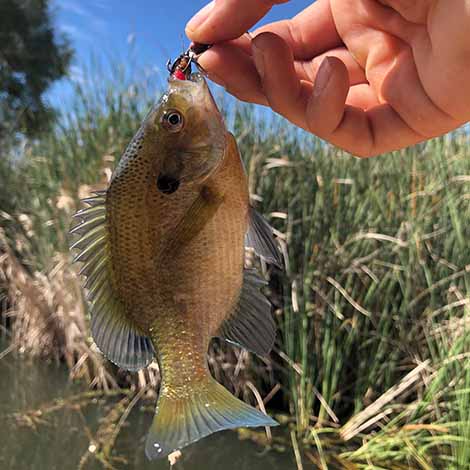Stocking up on fish for your pond can be fun and exciting, but if you're thinking of adding bluegill, knowing some of the key differences between hybrid and standard bluegill will help you maintain a balanced pond. Here's what you need to know about them and how to best stock them in your pond.
What's the Difference
Besides being the state fish of Illinois, standard bluegill are well known for being a feisty, delicious pan fish that thrive in streams, rivers, lakes and ponds. They grow to between 6 and 10 inches long, and appear olive green with an orange underbelly. Their uniform blue-black markings on their gills and fins give them their "bluegill" name. The issue with standard bluegill is they reproduce quickly and can take over a pond very fast if there is not a suitable predator fish population keeping them in check.
A hybrid bluegill is a cross between a male bluegill (Lepomis macrochirus) and a female sunfish (Lepomis cyanellus). A hybrid bluegill is an easy-to-catch, fast-growing game fish that makes a fun addition to recreational ponds and lakes. When the male bluegill and female sunfish mate, the resulting brood is 80 to 90 percent male. As a result, reproduction slows and the population count is kept in check - but you still have a good number of tasty fish growing in your pond.
Stocking Up
Whenever stocking any type of bluegill in a pond with other game fish, keeping the population in check is key. To do this you must have the correct ratio of predator fish such as bass or walleye. We recommend a 3 to 1 ratio between prey and predator. This means for every 3 prey, you need one predator. For example, if you stock 150 bluegill you will want approximately 50 bass. They should be around the same size as the hybrid bluegill so the two populations grow together.
In addition to predator fish, stock some forage species, like minnow or shiners, too. With proper habitat, this will give the small fish a chance to grow and provide everyone - predators and bluegill - with something to eat.
There are, however, some drawbacks to stocking your pond with hybrid bluegills alone. Because reproduction is slower, natural cycles and predator fish may result in dwindling fish populations over time. In those situations, restocking with additional bluegills and/or other feeder fish like minnows may be required every few years.
When stocked properly either type of bluegill delivers plenty of action making them great for fishing and a tasty meal!
